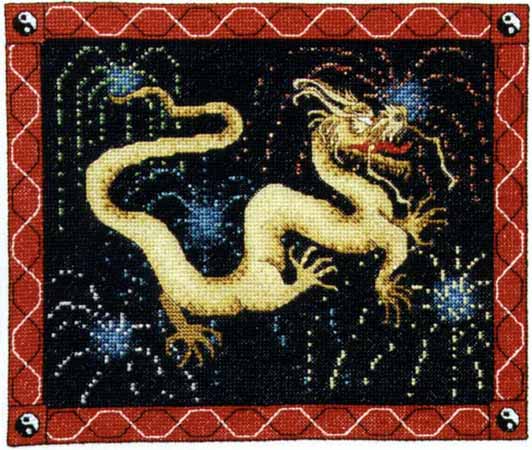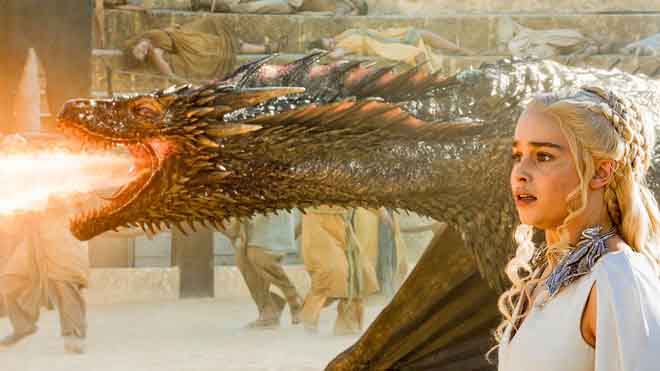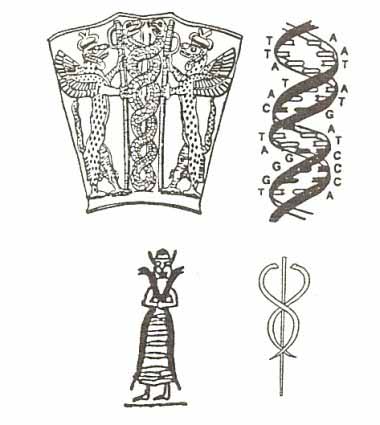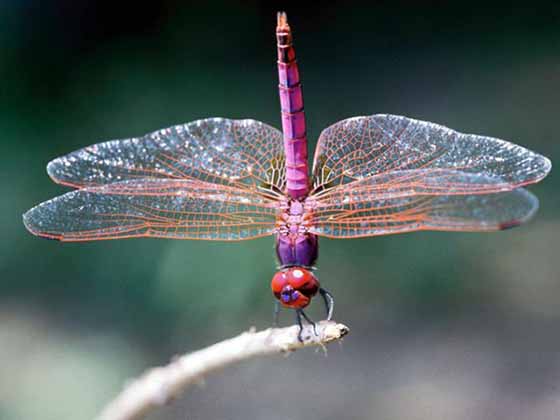

Mythology: Dragons are winged beings portrayed in the ancient mythologies of most cultures. Dragons were born of a time other than men, a time of chaos, creation out of destruction. The dragon is a fabulous and universal symbolic figure found in most cultures thought the world.
UFOology: Dragons link with winged gods in chariots of fire who came to Earth for different purposes. They are sometimes connected to a Reptilian race of aliens.
Symbolism: Dragons are symbols of human design - fire representing soul sparks of light emanating from the flame of creation.
Gnostics: "The way through all things."
Alchemy: "A winged dragon - the volatile elements; without wings - the fixed elements."
Guardian of the 'Flaming Pearl" symbol of spiritual perfection and powerful amulet of luck.
Chinese: "The spirit of the way"' bringing eternal change. The early Chinese believed in four magical, spiritual and benevolent animals; the Phoenix, the Tortoise and the Unicorn and the Dragon, the most revered of all. It holds an enormous magical pearl (DNA symbol), which has the power to multiply whatever it touches.
Many legends say dragons were fabulous animals usually represented as a monstrous winged and scaly serpent or saurian with a crested head and enormous claws represented usually as a gigantic reptile breathing fire and having a lion's claws, the tail of a serpent, wings and scaly skin.
The various figures now called dragons most likely have no single origin, but spontaneously came to be in several different cultures around the world, based loosely on the appearance of a snake and possibly fossilized dinosaur remains. Mythology about dragons appear in the traditions of virtually all peoples back to the beginning of time - though dragons appeared in various forms.
Among their earliest forms, dragons were associated with the Great Mother, the water god and the warrior sun god. In these capacities they had the power to be both beneficent and destructive and were all-powerful creatures in the universe. Because of these qualities, dragons assumed the roles taken by Osiris and Set in Egyptian mythology.
By the time of the early Egyptian period a considerable dragon- and serpent-worshipping cult had developed. This cult gradually spread to Babylon, India, the Orient, the Pacific Islands, and finally the North American continent, as more and more cultures began to recognize and appreciate the special powers and intelligence of dragons. The cult reached its peak during the days of the Roman Empire and disappeared with the advent of Christianity.
The dragon's form arose from his particular power of control over the waters of the earth and gave rise to many of the attributes singled out by different peoples as the whole myth developed.
They were believed to live at the bottom of the sea, where they guarded vast treasure hoards, very frequently of pearls.
Rain clouds and thunder and lightning were believed to be the dragon's breath, hence the fire-breathing monster.
The significance of the dragon was its control over the destiny of mankind.
As dragon mythology developed in the western world, dragons came to represent the chaos of original matter with the result that with man's awakening conscience a struggle arose, and the created order constantly challenged the dragon's power. This type of dragon was considered by many to be the intermediate stage between a demon and the Devil and as such came into Christian belief.
However, in the Eastern world the dragon adopted a rather different significance. He was essentially benevolent, son of heaven, and controlled the watery elements of the universe.
Dragons have been an integral part of the culture of the Chinese, Koreans and Japanese peoples since the beginning of recorded history. In China they are used to mark the stairways over which only the Emperor could be carried. In Japan they are used in Buddhist temples both as decoration and as fountain heads for purification before worship. In many cases the dragon is combined with the phoenix to symbolize long life and prosperity. It is also combined with the tiger to represent heaven and earth or Yin and Yang.
The male dragon holds a war club in its tail while the female dragon holds a sensu or fan in its tail. One of the problems lies in that you cannot always see the tail or tell the difference between the fan or the war club.
The Chinese dragon is a central figure of both good and evil in their fables and legends. According to the Chinese the dragon originated in their middle kingdom and has always had five toes. The dragon by nature is a gregarious creature who wanders the earth.
However, the farther it goes from China, the more toes it loses. Hence, when it reached Korea it only had four toes and by the time it got to Japan it only had three. This also explains why it never made it to Europe or the Americas in that by the time it got that far it had lost all of its toes and could not walk.

China Dragons
The Japanese account of the dragon is very similar to that of the Chinese. The Japanese also believe that the dragon had its origins in their country. Again they know that the dragon has a tendency to travel and the farther it travels, the more toes it grows. By the time it reached Korea it had four and by the time it got to China it had five. Again this is the reason it never made it much farther than China. It kept growing toes and could not walk any further.
The Koreans tell a similar story of the dragon. They of course know that the dragon began with them. Probably just like they know that karate began in Korea. The Korean dragon has always had four toes. When the dragon travels East or North, it loses toes. When it travels South or West it gains toes. This explains why the Japanese dragon has three toes and the Chinese dragon has five toes. It also explains why the dragon never made it to Europe or the Americas. As it traveled West to Europe, it grew so many toes that it could no longer walk. As it traveled East to the Americas, it lost all of its toes and could no longer walk.
The Western type of dragon has been variously described, and individual dragons had their own unique forms. They appeared to be created from parts of various creatures, with the result that in general, they were described as having eagle's feet and wings, lion's forelimbs and head, fish's scales, antelope's horns and a serpentine form of trunk and tail, which occasionally extended to the head.
In parts of Africa where the dragon is also considered as an evil power, the monster was believed to be the result of the unnatural union of an eagle and a she-wolf.
The destructive powers of the dragon derived from it's fiery breath, which can devastate whole countries. Dragon's eyes also have this fiery red quality, sometimes believed to reflect the treasures they guarded.
Later traditions believed that misers would assume the form of dragons by constantly gloating over their treasure.
The dragon fears nothing except the elephant with whom he will engage in battle, entwining himself around the elephant and inflicting fatal blows. However, as the elephant finally collapses, his fall crushes the dragon to death.
The dragon is supposedly the enemy of the sun and the moon, both in Eastern and Western mythology, and is believed to be responsible for eclipses. These occur when the dragon is attempting to swallow either of the heavenly bodies; which accounts for the dragon's appearance in primitive astronomy.
In Armenian traditions, the fire and lightning god had powers to stay the dragon's control of the heavens, as could thunderbolts in Macedonian myth. A dead man was thought to become a dragon, while dragons were believed to be the guardians of treasures in burial chambers.
Because the dragon was the natural enemy of man, his death became the ultimate goal, consequently there are innumerable battles between gods and dragons, saints and dragons, and in the medieval world, knights and dragons.
In Greek legends, the dragon fought on the side of the Titans and attacked Athena, who flung him into the heavens, where he became a constellation around the Pole Star.
Hercules encountered, and killed the dragon Ladon while fulfilling his eleventh labor.
In Scandinavian literature, Beowulf was slain by a dragon.
The dragon turns up in myths across Europe, Asia, Africa, and the Americas.
Travel to any part of the world and it’s hard not to find dragons lurking in their mythological folklore. The ancient legends of Europe, Asia, Africa, and the Americas all feature the figure of a slinky crocodile-like creature with long talons and a fierce look in its eyes. The question is: why have a significant number of civilizations independently conjured up the myth of the dragon despite it never existing in reality?
First, it is a bit reductive to assume that all dragons are the same. The dragons of Middle Ages Europe are often fire-breathing lizard-like beasts with strong bodies, bat-like wings, and horns. They are typically seen as evil beings. Tales from folklore often involve a brave hero slaying the dragon to snatch its hoard of wealth or liberate its kingdom of terrified townsfolk. Even within depictions of European dragons though, there's a wealth of diversity.
In East Asian culture, the dragon can play a slightly different role. Often taking on a more mystical aura, dragons are used as a symbol of power, strength, and good luck. One well-known dragon of Chinese culture is Tianlong, the "celestial dragon" that is said to have drifted among the clouds and guarded heaven.
Another theory is that dragons are an archetype buried deep within the human mind. In the book An Instinct for Dragons, University of Central Florida anthropologist Dr David E. Jones argues that myths about dragons are so common because we’ve evolved to develop a mental imprint of dangerous predators.
The dragon, Jones argues, has many motifs that our early ancestors learned to innately fear in wild animals. This primal instinct resulted in our imaginations creating an archetypal creature that fuses all of the most ferocious features of a crocodile, a snake, a bird of prey, and a big cat.
Whatever the reason behind this ubiquitous myth, dragons clearly have a hold on us. They've stuck around for thousands of years and continue to be an object of fascination, featuring in some of the most popular works of fiction, whether it's The Hobbit and the Harry Potter series, or Game of Thrones and Pokemon.

Can Any Animal Breathe Fire Like the Mythical Dragon? Live Science - April 13, 2019
Dragons have the ultimate built-in defense: They can breathe fire, smiting their enemies by turning them into charred husks. But though historic and modern-day literature is rich with dragon lore (we're looking at you, "Game of Thrones"), there isn't any reputable physical evidence that these legendary creatures exist. That said, are there any living creatures that can breathe fire like the mythical dragon? The short answer is no, but there are some astonishingly creative animals that can spew noxious fumes, toxins and goo from their bodies. And there are even crafty raptors that spread fire so they can smoke out tasty prey.

Caduceus Rod of Hermes, DNA
Release of Information from the 8 Origin Cells at the Base of the Spine

Spiraling DNA, Golden Ratio, Fibonacci Numbers, Consciousness

Dragonflies